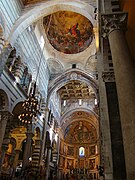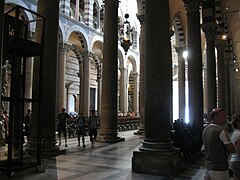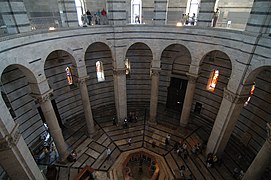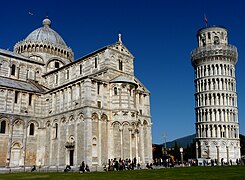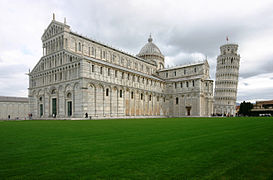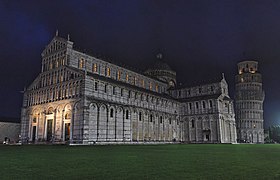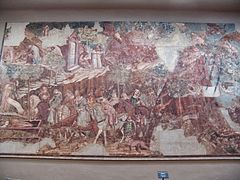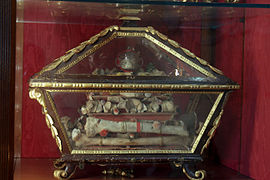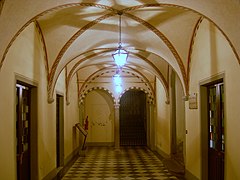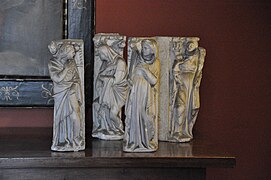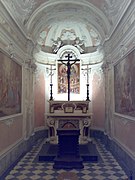Piazza dei Miracoli
| UNESCO World Heritage Site | |
|---|---|
 The Baptistry on the left, the Duomo in the center, and the Campanile on the right | |
| Location | Pisa,Tuscany,Italy |
| Includes | Baptistery,Leaning Tower,CathedralandCamposanto Monumentale |
| Criteria | Cultural: (i), (ii), (iv), (vi) |
| Reference | 395 |
| Inscription | 1987 (11thSession) |
| Area | 8.87 ha (21.9 acres) |
| Buffer zone | 254 ha (630 acres) |
| Coordinates | 43°43′23″N10°23′47″E/ 43.72306°N 10.39639°E |

ThePiazza dei Miracoli(Italian:[ˈpjattsadeimiˈraːkoli];'Square of Miracles'), formally known asPiazza del Duomo('Cathedral Square'), is a walled 8.87-hectare (21.9-acre) compound in centralPisa,Tuscany,Italy, recognized as an important center of Europeanmedieval artand one of the finest architectural complexes in the world.[1]It was all owned by theCatholic Churchand is dominated by four great religious edifices:Pisa Cathedral,thePisa Baptistery,theLeaning Tower of Pisa(the cathedral'scampanileor bell tower), and theCamposanto Monumentale('Monumental Cemetery'). Partly paved and partly grassed, the Piazza dei Miracoli is also the site of the Ospedale Nuovo di Santo Spirito ('New Hospital of the Holy Spirit'), which now houses the Sinopias Museum (Museo delle Sinopie) and the Cathedral Museum (Museo dell'Opera del Duomo).
The square's popular name was coined by the Italian writer and poetGabriele D'Annunziowho, in his novelForse che sì forse che no(1910), described the square as the "prato dei Miracoli",or 'meadow of miracles'. It is also sometimes called theCampo dei Miracoli('Field of Miracles'). In 1987, the whole square was declared aUNESCOWorld Heritage Site.
Cathedral[edit]

The Piazza del Duomo is dominated byPisa Cathedral(theDuomo), the medieval cathedral of theArchdiocese of Pisa,dedicated to Santa Maria Assunta (Saint Mary of the Assumption). The cathedral has two aisles on either side of the nave. The transept consists of three aisles. The church is known also as thePrimatial,the archbishop of Pisa having been aPrimatesince 1092.
Its construction began in 1064 to the designs of the architectBuscheto.It set the model for the distinctivePisan Romanesque styleof architecture. The mosaics of the interior, as well as the pointed arches, show a strongByzantineinfluence.
The façade, of greymarbleand white stone set with discs of coloured marble, was built by a master namedRainaldo,as indicated by an inscription above the middle door:Rainaldus prudens operator.
The massivebronzemain doors were made in the workshops ofGiambologna,replacing the original doors destroyed in a fire in 1595. The original central door was of bronze, executed around 1180 byBonanno Pisano,while the other two were probably of wood. However, worshippers have never used the façade doors to enter, instead entering by way of thePorta di San Ranieri(Saint Ranieri's Door), in front of the Leaning Tower, built around 1180 by Bonanno Pisano.

Above the doors are four rows of open galleries with, on top, statues of the Madonna with Child and, on the corners, the Four Evangelists.
Also in the façade is found the tomb of Buscheto (on the left side) and an inscription about the foundation of the cathedral and the victorious battle against theSaracens.
At the east end of the exterior, high on a column rising from thegable,is a modern replica of thePisa Griffin,the largest knownIslamic metal sculpture,the original of which was placed there probably in the 11th or 12th century, and is now in the Cathedral Museum.
The interior is faced with black and white marble and has agildedceiling and afrescoeddome.It was largely redecorated after a fire in 1595, which destroyed most of the Renaissance artworks.
The impressivemosaicofChrist in Majesty,in theapse,flanked by theVirgin and Saint John the Evangelist,survived the fire. It evokes the mosaics in the church ofMonreale,Sicily.Although it is said that the mosaic was the work ofCimabue,only the head of Saint John was executed by that artist in 1302, his last work, since he died in Pisa the same year. The cupola, at the intersection of thenaveandtransept,was decorated byRiminaldishowing theassumption of the Virgin.

Galileois believed to have formulated his theory about the movement of apendulumby watching the swinging of theincenselamp (not the present one) hanging from the ceiling of thenave.That lamp, smaller and simpler than the present one, is now kept in the Camposanto, in the Aulla chapel.
The granite Corinthian columns between the nave and the aisle came originally from themosqueofPalermo,captured by the Pisans in 1063.
Thecoffered ceilingof the nave was replaced after the fire of 1595. The present gold-decorated ceiling carries the coat of arms of theMedici.
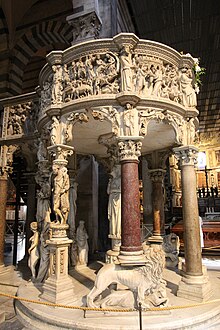
The elaborately carvedpulpit(1302–1310), which also survived the fire, was executed byGiovanni Pisano,and is a masterpiece of medieval sculpture. Having been packed away during the redecoration, it was not rediscovered and restored until 1926. The pulpit is supported by plain columns (two of which are mounted on lion's sculptures) on one side and bycaryatidsand atelamonon the other: the latter represent Saint Michael, the Evangelists, the fourcardinal virtuesflanking the church, and a bold, naturalistic depiction of a nakedHercules.A centralplinthwith theliberal artssupports the fourtheological virtues.
The present-day pulpit is a reconstruction of the original. It does not lie in its original position, which was nearer the main altar, and the columns and panels are not original. The original stairs (perhaps of marble) were lost.
The upper part has nine narrative panels showing scenes from the New Testament, carved in white marble with achiaroscuroeffect and separated by figures of prophets: the Annunciation, theMassacre of the Innocents,the Nativity,Adoration of the Magi,the Flight into Egypt, the Crucifixion, and two panels of the Last Judgement.
The church also contains the bones of SaintRanieri,Pisa'spatron saint,and the tomb ofHoly Roman EmperorHenry VII,carved byTino da Camainoin 1315. That tomb, originally in the apse just behind the main altar, was disassembled and moved many times over the centuries for political reasons. While the sarcophagus is still in the cathedral, some of the statues were put in the Camposanto or at the top of the cathedral's façade. The original statues are now in the Museo dell'Opera del Duomo.
Pope Gregory VIIIwas also buried in the cathedral. The fire of 1595 destroyed his tomb.
The cathedral has a prominent role in determining the beginning of the Pisan New Year. Between the tenth century and 1749, when the Tuscan calendar was reformed, Pisa used its own calendar, in which the first day of the year was March 25, thefeast dayof theAnnunciation of Mary.Years were counted such that the Pisan New Year begins nine months before the ordinary one. The exact moment is determined by a ray of sun that, through a window on the left side, falls on an egg-shaped marble, just above the pulpit by Giovanni Pisano; this occurs at noon.
Some relics brought back during the Crusades can also be found in the cathedral: alleged remains of threesaints(Abibo,Gamaliel,andNicodemus), and a vase that is said to be one of thejars of Cana.
The building, as have several in Pisa, has tilted slightly since its construction, though not nearly to the extent of the nearbyTower.
-
Lunette above the central door by Giuseppe Modena da Lucca, representing the Virgin Mary
-
Apse with mosaic
-
Altar ofSaint Rainerius
-
Interior view of central part
-
Marble columns
-
The Compound, with thePisa Griffinhigh above the apse on a column
-
Aerial perspective of Piazza del Duomo
-
The Leaning Tower with the Duomo and Baptistery at night
-
Details in Romanesque architecture style
-
White marble statue
-
In front of the altar
-
Madonna and Child
-
Interior view

Baptistery[edit]

The Baptistery, dedicated to St. John the Baptist, stands opposite the west end of the Duomo. The round Romanesque building was begun in the mid 12th century:1153 Mense August fundata fuit haec( "In the month of August 1153 was set up here..." ). It was built inRomanesquestyle by anarchitectknown asDiotisalvi( "God Save You" ), who worked also in the church of theHoly Sepulchrein the city. His name is mentioned on a pillar inside, asDiotosalvi magister.the construction was not, however, finished until the 14th century, when theloggia,the top storey and the dome were added inGothicstyle byNicola PisanoandGiovanni Pisano.
It is the largestbaptisteryin Italy, with a circumference measuring 107.25 m. Taking into account the statue of St. John the Baptist (attributed to Turino di Sano) atop the dome, it is even a few centimetres taller than the Leaning Tower.
The portal, facing the façade of the cathedral, is flanked by two classical columns, while the inner jambs are executed in theByzantinestyle. Thelintelis divided into two tiers, the lower one depicting several episodes in the life of St. John the Baptist, and the upper one showing Christ between the Madonna and St. John the Baptist, flanked by angels and the evangelists.
The immensity of the interior is overwhelming, but it is surprisingly plain and lacking in decoration. It has notableacousticsalso.
The octagonalbaptismal fontat the centre dates from 1246 and was made by Guido Bigarelli da Como. The bronze sculpture of St. John the Baptist at the centre of the font is a remarkable work by Italo Griselli.
Thefamous pulpitwas sculpted between 1255 and 1260 byNicola Pisano,father ofGiovanni Pisano,the artist who produced the pulpit in the Duomo. The scenes on the pulpit, and especially the classical form of the nakedHercules,show at best Nicola Pisano's abilities as the most important precursor of Italian renaissance sculpture by reinstating antique representations.[2]Therefore, surveys of the Italian Renaissance usually begin with the year 1260, the year that Nicola Pisano dated this pulpit.[3]
-
Baptistry dome
-
Baptistry interior
-
Baptistry font by Guido Bigarelli da Como
-
Pulpit by Nicola Pisano
-
Stained-glass window
-
Baptistery floor
Campanile[edit]

The campanile (bell tower), commonly known as theLeaning Tower of Pisa,is located behind the cathedral. The last of the three major buildings on the piazza to be built, construction of the bell tower began in 1173 and took place in three stages over the course of 177 years, with the bell-chamber only added in 1372. Five years after construction began, when the building had reached the third floor level, the weak subsoil and poor foundation led to the building sinking on its south side. The building was left for a century, which allowed the subsoil to stabilise itself and prevented the building from collapsing. In 1272, to adjust the lean of the building, when construction resumed, the upper floors were built with one side taller than the other. The seventh and final floor was added in 1319. By the time the building was completed, the lean was approximately 1 degree, or 80 cm (2.5 feet) from vertical. At its greatest, measured prior to 1990, the lean measured approximately 5.5 degrees. As at 2010, the lean was reduced to approximately 4 degrees.
The tower stands approximately 60 m high, and was built to accommodate a total of seven main bells, cast to themusical scale:
- L'Assunta,cast in 1654 by Giovanni Pietro Orlandi, weight 3,620 kg (7,981 lb)
- Il Crocifisso,cast in 1572 by Vincenzo Possenti, weight 2,462 kg (5,428 lb)
- San Ranieri,cast in 1719–21 by Giovanni Andrea Moreni, weight 1,448 kg (3,192 lb)
- La Terza,the first small bell, cast in 1473, weight 300 kg (661 lb)
- La PasquerecciaorLa Giustizia,cast in 1262 by Lotteringo, weight 1,014 kg (2,235 lb)
- Il Vespruccio,the second small bell, cast in the 14th century and again in 1501 by Nicola di Jacopo, weight 1,000 kg (2,205 lb)
- Dal Pozzo,cast in 1606 and again in 2004, weight 652 kg (1,437 lb)[4]
There are 296 steps leading to the top of the tower.
-
Leaning Tower of Pisa and Pisa Cathedral
-
Leaning Tower of Pisa and Pisa Cathedral
-
Cathedral and Campanile
-
Duomo di Pisa by night
-
Leaning Tower of Pisa and Pisa Cathedral
-
Leaning Tower of Pisa
Camposanto Monumentale[edit]
TheCamposanto Monumentale(Monumental Cemetery), also known asCampo SantoorCamposanto Vecchio(Old Cemetery), is located at the northern edge of the square. This walledcemeteryis said to have been built around a shipload of sacred soil fromCalvary,brought back to Pisa from theThird Crusadeby Ubaldo de' Lanfranchi, thearchbishop of Pisain the 12th century. This is where the nameCampo Santo(Holy Field) originates.
The building itself dates from a century later and was erected over the earlier burial ground. The building of this huge, oblong Gothiccloisterbegan in 1278 by the architect Giovanni di Simone. He died in 1284 when Pisa suffered a defeat in a navalbattle of Meloriaagainst the Genoans. The cemetery was only completed in 1464. The outer wall is composed of 43 blind arches. There are two doorways. The one on the right is crowned by a gracious Gothic tabernacle and contains theVirgin Mary with Childsurrounded by four saints. It is the work from the second half of the 14th century by a follower ofGiovanni Pisano.Most of the tombs are under the arcades, although a few are on the central lawn. The inner court is surrounded by elaborate round arches with slendermullionsand plurilobedtracery.
The Camposanto Monumentale once contained a large collection of Roman sculptures andsarcophagi,but now there are only 84 remaining. The walls were once covered infrescoes,the first were applied in 1360, the last about three centuries later. TheStories of the Old TestamentbyBenozzo Gozzoli(c. 15th century) were situated in the north gallery, while the south arcade was famous for theStories of the GenesisbyPiero di Puccio(c. late 15th century). The most remarkable fresco isThe Triumph of Death,a realistic work byBuonamico Buffalmacco.On 27 July 1944,incendiary bombsdropped byAlliedaircraft set the roof of the building on fire and covered them in molten lead, all but destroying them. Since 1945, restoration works have been going on and now the Campo Santo has been brought back to its original state.
-
Camposanto Monumentale interior
-
Hallway in Camposanto Monumentale
-
Frescos in Camposanto Monumentale
-
Some of the Saints' relics in the Dal Pozzo chapel
-
Chains of the medieval harbour of Pisa
Ospedale Nuovo di Santo Spirito[edit]

The Ospedale Nuovo di Santo Spirito (New Hospital of Holy Spirit) is located on the south area of the square. Built in 1257 by Giovanni di Simone over a preexisting smaller hospital, the function of this hospital was to help pilgrims, poor, sick people, and abandoned children by providing a shelter. The name of the hospital was later changed to Ospedale della Misericordia (Hospital of Mercy) or di Santa Chiara (Sant Claire), which was the name of the small church included in the complex.
The hospital exterior was constructed with brick walls with two-light windows in gothic style; the hospital interior was painted in two colours, black and white, to imitate the marble colours of the other buildings. In 1562, during the time when the Medici dominated the city, the hospital was restructured according to Florentine renaissance canons; all the doors and windows were modified with new rectangular ones encased in grey sandstone.
Today, the building is no longer entirely a hospital. Since 1976, the middle part of the building contains the Sinopias Museum, where original drawings of the Campo Santo frescoes are kept.
Palazzo dell'Opera[edit]
The Palazzo dell'Opera (Opera in the sense of "works" - these were the workshops of the complex) is at the south east corner of the square. Parts have been built in different periods, with the main building dating back to at least the 14th century and the latest to the 19th century.
Originally these houses belonged to the workmen of the cathedral complex: the tailor, the gardener, the bell ringers, etc., until the 19th century when the administration offices of the Opera della Primaziale were moved in. In the same years thechapter housewas also moved inside the complex. In the course of time the complex was rearranged several times, but the façade of the main building still conserves its original aspect.
In the first years of the 21st century the administration offices and the chapter moved again to a nearby palace close to the archbishopric. Only a few rooms on the ground floor are still used as offices for the surveillance and technical staff. After the move, the upper rooms were transformed in a platform for temporary exhibitions (2014). This is the first time people can actually visit those rooms.
The most interesting rooms open to the public are the President room, the Deputation room, the chapel and the Chapter room. Among the closed ones are the "Loggetta" room (with frescoes byAgostino Ghirlanda), the "Scrittoio" room (with a fresco byIl Sodoma), the "Viola" room and the technical room.
-
Main entrance
-
The corridor in the ground floor
-
Fresco in the technical room, painted in the first quarter of the 15th century by a senese painter
-
Fresco in the Deputation room, painted in 1299 byVincino di VanniandGiovanni d'Apparecchiato
-
Some of the original parts of theGiovanni Pisano's pulpit in the President room
-
ThePisa Griffinin the Chapter room
-
Chapel
See also[edit]
- Ablaq
- Architecture of cathedrals and great churches
- Cathedrals in Italy
- History of medieval Arabic and Western European domes
- Pisa cathedral
References[edit]
- ^Renzulli, Melanie (2010). Rachel Mills (ed.).The Green Guide: Italy.Greenville, SC: Michelin. p.328.ISBN9781907099571.
- ^Barsali, G.; U. Castelli, R. Gagetti, O. Parra (1995).Pisa, History and Masterpieces.Florence: Bonechi Edizioni "Il Turismo" S.r.l. p. 46.ISBN88-7204-192-9.
{{cite book}}:CS1 maint: multiple names: authors list (link) - ^Michael Greenhalgh (1978)."Classicism from the Fall of Rome to Nicola Pisano: Survival and Revival".Retrieved18 September2007.
- ^"Leaning Tower of Pisa: 1920s Photo of Dal Pozzo".www.endex.com. Archived fromthe originalon 18 April 2010.Retrieved9 August2010.
Sources[edit]
- Tobino, Mario (1982).Pisa la Piazza dei Miracoli.De Agostini.
External links[edit]
- Official website
- Photo gallery
- Field of MiraclesArchived23 January 2019 at theWayback Machine
- Interactive High resolution 360° Panoramic Photo of Piazza dei MiracoliVirtual Tour by Hans von Weissenfluh
- Piazza dei Miracoli digital media archive(creative commons-licensed photos, laser scans, panoramas), data from aUniversity of Ferrara/CyArkresearch partnership.



